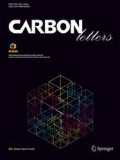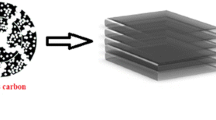Abstract
Preparation of activated carbons from wood waste including northern hardwood pins-fines and wood dust was conducted and then compared through the following methods: physical pyrolysis and CO2 activation, vacuum pyrolysis and CO2 activation, CO2 gasification, and vacuum CO2 gasification processes. Experimental results show that chars and activated carbons with high surface area and pore volume are produced from wood waste through a vacuum CO2 pyrolysis/gasification process. The effects of operation variables of vacuum pyrolysis/gasification on the properties of chars and activated carbons were investigated to identify and optimize the temperature, heating time, and heating rate. The optimized vacuum CO2 gasification conditions were found to be a temperature of 800 °C, a heating rate of 20 °C/min, and a holding time of 2 h respectively. The prepared wood-chars and activated carbons were characterized by nitrogen physisorption, scanning electron microscopy (SEM). Fourier transform infrared (FTIR) spectra determined any changes in the surface functional groups produced during different preparation stages.
Graphic abstract














Similar content being viewed by others
References
Saleem J, Shahid U, Hijab M et al (2019) Production and applications of activated carbons as adsorbents from olive stones. Biomass Conv Bioref 9:775–802
Peng G, Gramm F, Ludwiga C, Vogel F (2015) Effect of carbon surface functional groups on the synthesis of Ru/C catalysts for supercritical water gasification. Catal Sci Technol 5:3658–3666
Bagheri S, Julkapli NM (2016) Effect of hybridization on the value-added activated carbon materials. Int J Ind Chem 7:249–264
Adegoke KA, Bello OS (2015) Dye sequestration using agricultural wastes as adsorbents. Water Resour Indus 12:8–24
Menendez-Diaz JA, Martin-Gullon I (2006) Types of carbon adsorbents and their production. In: Bandosz TJ (ed) Activated carbon surfaces in environmental remediation. Academic Press, New York, pp 1–47
Schlesinger WH, Bernhardt ES (2013) Chapter 5 the biosphere: the carbon cycle of terrestrial ecosystems. Biogeochemistry: an analysis of global change, 3rd edn. Academic Press, Boston, pp 135–171
Jahanban-Esfahlan A, Ostadrahimi A, Tabibiazar M, Amarowicz R (2019) A comparative review on the extraction, antioxidant content and antioxidant potential of different parts of walnut (Juglans regia L.) fruit and tree. Molecules 24:2133
Field CB, Behrenfeld MJ, Randerson JT, Falkowski P (1998) Primary production of the biosphere: integrating terrestrial and oceanic components. Science 281:237–240
Amirza MAR, Adib MMR, Hamdan R (2017) Preface. MATEC Web Conf 103:1–12
Agblevor FA, Besler S (1996) Inorganic compounds in biomass feedstocks. 1 Effect on the quality of fast pyrolysis oils. Energy Fuels 10:293–298
Dias JM, Alvim-Ferraz MC, Almeida MF, Rivera-Utrilla J, Sanchez-Polo M (2007) Waste materials for activated carbon preparation and its use in aqueous-phase treatment: a review. J Environ Manag 85:833–846
Falk B (1997) Opportunities for the woodwaste resource. For Prod J 47:17–22
Prairie Village KS (1998) Characterization of building-related construction and demolition debris in the United States. The U.S. Environmental Protection Agency Municipal and Industrial Solid Waste Division Office of Solid Waste, Prairie Village, Kansas, 1998.
Nelson L, Park S, Hubbe MA (2018) Thermal depolymerization of biomass with emphasis on gasifier design and best method for catalytic hot gas conditioning. BioRes 13:4630–4727
Hanks L (1977) Predicted cubic-foot yields of lumber, sawdust, and sawmill residue from the sawtimber portions of hardwood trees. Research Paper NE-380. USDA Forest Service, Northeastern Experiment Station, Upper Darby, Pennsylvania.
Ince PJ, McKeever DB (1995) Recovery of paper and wood for recycling: actual and potential. General Technical Report FPL-GTR88. USDA Forest Service, Forest Products Laboratory, Madison, p 13
Grigoriou AH (2003) Waste paper–wood composites bonded with isocyanate. Wood Sci Technol 37:79–90
Xiu S, Shahbazi A (2012) Bio-oil production and upgrading research: a review. Renew Sustain Energy Rev 16:4406–4414
Hata T, Vystavel T, Bronsveld P, De Hosson J, Kikuchi H, Nishimiya K, Imamura Y (2004) Catalytic carbonization of wood charcoal: graphite or diamond? Carbon 42:961–964
Yan Q, Li J, Zhang X, Zhang J, Cai Z (2019) Mass production of graphene materials from solid carbon sources using a molecular cracking and welding method. J Mater Chem A 7:13978–13985
Rosales-Calderon O, Arantes V (2019) A review on commercial-scale high-value products that can be produced alongside cellulosic ethanol. Biotechnol Biofuels 12:240
Shi K, Yan J, Menéndez JA, Luo X, Yang G, Chen Y, Lester E, Wu T (2020) Production of H2-rich syngas from lignocellulosic biomass using microwave-assisted pyrolysis coupled with activated carbon enabled reforming. Front Chem 8:3
Dąbrowski A, Podkościelny P, Hubicki Z, Barczak M (2005) Adsorption of phenolic compounds by activated carbon. A critical review. Chemosphere 58:1049–1070
Hayashi JI, Horikawa T, Takeda I, Muroyama K, Ani F (2002) Preparing activated carbon from various nutshells by chemical activation with K2CO3. Carbon 40:2381–2386
Machrouhi A et al (2019) Statistical optimization of activated carbon from Thapsia transtagana stems and dyes removal efficiency using central composite design. J Sci Adv Mater Devices 4:544–553
Şahin Ö, Saka C (2013) Preparation and characterization of activated carbon from acorn shell by physical activation with H2O–CO2 in two-step pretreatment. Bioresour Technol 136:163–168
Bae W, Kim J, Chung J (2014) Production of granular activated carbon from food-processing wastes (walnut shells and jujube seeds) and its adsorptive properties. J Air Waste Manag Assoc 64:879–886
Kawamoto H (2017) Lignin pyrolysis reactions. J Wood Sci 63:117–132
Libbrecht W, Vandaele K, De Buysser K, Verberckmoes A, Thybaut J, Poelman H, De Clercq J, Van Der Voort P (2015) Tuning the pore geometry ofordered mesoporous carbons for enhanced adsorption of bisphenol-a. Materials 8:1652–1665
Dufour A, Celzard A, Fierro V, Martin E, Broust F, Zoulalian A (2008) Catalytic decomposition of methane over a wood char concurrently activated by a pyrolysis gas. Appl Catal A Gen 346:164–173
Carrier M, Hardie AG, Uras U, Gorgens J, Knoetze JH (2012) Production of char from vacuum pyrolysis of South-African sugar cane bagasse and its characterization as activated carbon and biochar. J Anal Appl Pyrolysis 96:24–32
Plante P, Roy C, Chornet E (1988) CO gasification of wood charcoals derived from vacuum and atmospheric pyrolysis. Can J Chem Eng 66:307–312
Ismadji S, Sudaryanto Y, Hartono SB, Setiawan LE, Ayucitra A (2005) Activated carbon from char obtained from vacuum pyrolysis of teak sawdust: pore structure development and characterization. Bioresour Technol 96:1364–1369
Cao N, Darmstadt H, Roy C (2001) Activated carbon produced from charcoal obtained by vacuum pyrolysis of softwood bark residues. Energy Fuels 15:1263–1269
Cao NZ, Darmstadt H, Soutric F, Roy C (2002) Thermogravimetric study on the steam activation of charcoal obtained by pyrolysis of bark residue. Carbon 40:471–479
ASTM D4442-07 (2007) Standard test methods for direct moisture content measurement of wood and wood-based materials. ASTM Int., West Conshohocken
ASTM D1102-84 (2007) Standard test method for ash in wood. ASTM Int., West Conshohocken
Yan Q, Boardman CR, Cai Z (2020) Thermal stability of metal-lignin composites prepared by coprecipitation method. Thermochim Acta 690:178659
Leal GF, Ramos LA, Barrett DH, Curvelo AAS, Rodella CB (2015) A thermogravimetric analysis (TGA) method to determine the catalytic conversion of cellulose from carbon-supported hydrogenolysis process. Thermochim Acta 616:9–13
Yan Q, Li J, Zhang J, Cai Z (2018) Thermal decomposition of kraft lignin under gas atmospheres of argon, hydrogen, and carbon dioxide. Polymers 10:729
González-Díaz E, Alonso-López JM (2017) Characterization by thermogravimetric analysis of the wood used in Canary architectural heritage. J Cult Herit 23:111–118
Gašparovič L, Koreňová Z, Jelemenský L (2010) Kinetic study of wood chips decomposition by TGA. Chem Pap 64:174–181
Poletto M, Dettenborn J, Pistor V, Zeni M, Zattera AJ (2010) Materials produced from plant biomass. Part I: evaluation of thermal stability and pyrolysis of wood. Mater Res 13:375–379
Zghari B, Doumenq P, Romane A, Boukir A (2017) GC-MS, FTIR and 1H, 13C NMR structural analysis and identification of phenolic compounds in olive mill wastewater extracted from oued Oussefrou effluent (Beni Mellal-Morocco). J Mater Environ Sci 8:4496–4509
Awal A, Sain M (2011) Spectroscopic studies and evaluation of thermorheological properties of softwood and hardwood lignin. J Appl Polym Sci 122:956–963
Guo Y, Bustin RM (1998) FTIR spectroscopy and reflectance of modern charcoals and fungal decayed woods: implications for studies of inertinite in coals. Int J Coal Geol 37:29–53
Hajji L, Boukir A, Assouik J, Pessanha S, Figueirinhas JL, De Carvalho ML (2016) Artificial ageing paper to assess long term effects of conservative treatment. Monitoring by infrared spectroscopy (ATR-FTIR), X-ray diffraction (XRD) and Energy dispersive X-ray fluorescence (EDXRF). Microchem J 124:646–656
Emmanuel V, Odile B, Céline R (2015) FTIR spectroscopy of woods: a new approach to study the weathering of the carving face of a sculpture. Spectrochim Acta A Mol Biomol Spectrosc 136:1255–1259
Oh SY, Yoo DI, Shin Y, Seo G (2005) FTIR analysis of cellulose treated with sodium hydroxide and carbon dioxide. Carbohydr Res 340:417–428
Gronert S (2006) Evidence that alkyl substitution provides little stabilization to radicals: the C−C bond test and the nonbonded interaction contradiction. J Org Chem 71:7045–7048
Liu Q, Wang S, Zheng Y, Luo Z, Cen K (2008) Mechanism study of wood lignin pyrolysis by using TG–FTIR analysis. J Anal Appl Pyrolysis 82:170–177
Wang S, Wang K, Liu Q, Gu Y, Luo Z, Cen K, Fransson T (2009) Comparison of the pyrolysis behavior of lignins from different tree species. Biotechnol Adv 27:562–567
Kishimoto T, Uraki Y, Ubukata M (2006) Chemical synthesis of β-O-4 type artificial lignin. Org Biomol Chem 4:1343–1347
Zhao J, Wang X, Hu J, Liu Q, Shen D, Xiao R (2014) Thermal degradation of softwood lignin and hardwood lignin by TG-FTIR and Py-GC/MS. Polym Degrad Stab 108:133–138
Safdari MS, Rahmati M, Amini E, Howarth JE, Berryhill JP, Dietenberger M, Weise DR, Fletcher TH (2018) Characterization of pyrolysis products from fast pyrolysis of live and dead vegetation native to the Southern United States. Fuel 229:151–166
Zaman CZ, Pal K, Yehye WA, Sagadevan S, Shah ST, Adebisi GA, Marliana E, Rafique RF, Johan RB (2017) Pyrolysis: a sustainable way to generate energy from waste. Book: pyrolysis. InTech, London, pp 3–34. https://doi.org/10.5772/intechopen.69036
Yan Q, Toghiani H, Yu F, Cai Z, Zhang J (2011) Effects of pyrolysis conditions on yield of bio-chars from pine chips. For Prod J 61:367–371
Lua AC, Yang T (2004) Effects of vacuum pyrolysis conditions on the characteristics of activated carbons derived from pistachio-nut shells. J Colloid Interface Sci 276:364–372
Nowicki P, Pietrzak R (2010) Carbonaceous adsorbents prepared by physical activation of pine sawdust and their application for removal of NO2 in dry and wet conditions. Bioresour Technol 101:5802–5807
Tseng RL, Wu FC, Juang RS (2003) Liquid-phase adsorption of dyes and phenols using pinewood-based activated carbons. Carbon 41:487–495
Zhang T, Walawender WP, Fan LT, Fan M, Daugaard D, Brown RC (2004) Preparation of activated carbon from forest and agricultural residues through CO2 activation. Chem Eng J 105:53–59
Malik PK (2004) Dye removal from wastewater using activated carbon developed from sawdust: adsorption equilibrium and kinetics. J Hazard Mater 113:81–88
Wu FC, Tseng RL, Juang RS (2005) Preparation of highly microporous carbons from fir wood by KOH activation for adsorption of dyes and phenols from water. Sep Purif Technol 47:10–19
Ngernyen Y, Tangsathitkulchai C, Tangsathitkulchai M (2006) Porous properties of activated carbon produced from Eucalyptus and Wattle wood by carbon dioxide activation. Korean J Chem Eng 23:1046–1054
Acknowledgements
This work was supported by the USDA Forest Service through Grant Nos. 19-JV-11111124-053 and 19-JV-11111124-063. The authors would like to acknowledge Domtar Corp., North Carolina for providing wood pins-fines and wood dust samples for this study. Neil Gribbins and Timothy Ketelboeter at USDA Forest Products Laboratory provided editorial assistance.
Author information
Authors and Affiliations
Corresponding author
Additional information
Publisher's Note
Springer Nature remains neutral with regard to jurisdictional claims in published maps and institutional affiliations.
Rights and permissions
About this article
Cite this article
Yan, Q., Li, J. & Cai, Z. Preparation and characterization of chars and activated carbons from wood wastes. Carbon Lett. 31, 941–956 (2021). https://doi.org/10.1007/s42823-020-00205-2
Received:
Revised:
Accepted:
Published:
Issue Date:
DOI: https://doi.org/10.1007/s42823-020-00205-2




